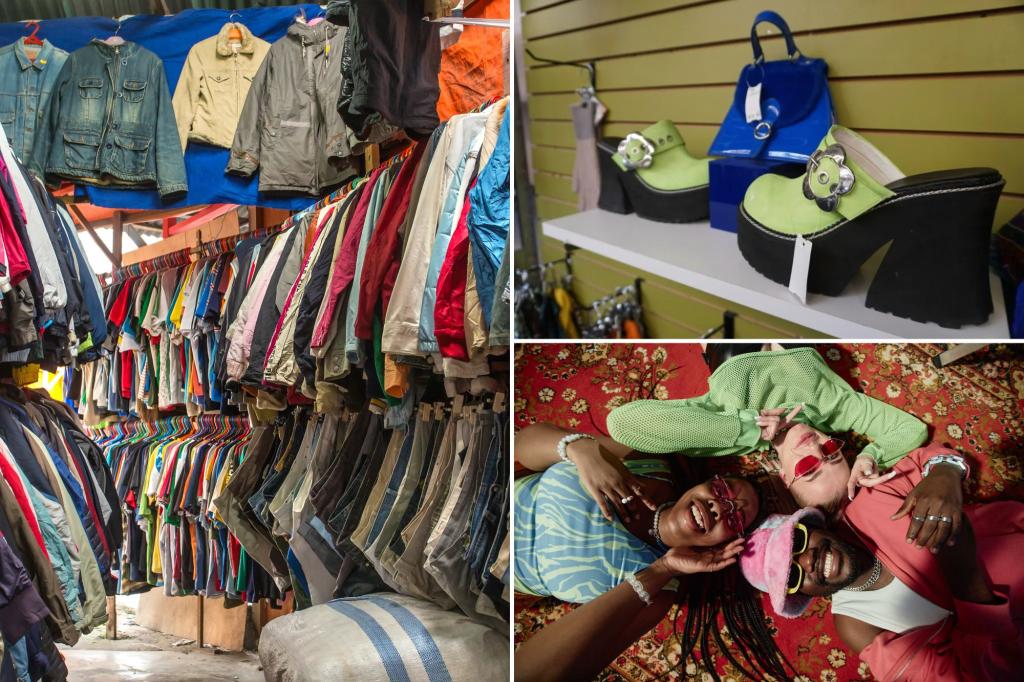From Juicy Couture sweat sets and low-rise, bedazzled jeans to chunky belts and baby tees, early 2000s fashion is all the rage again. That potentially makes that old box of clothes in the back of your closet a sitting cash cow.
Generation Z — born from about 1997 to 2012 — has taken to the Y2K aesthetic that many millennials cringe at.
Fashion-forward college students and TikTok influencers are flaunting the miniskirts, chunky sandals, and other bright, brand-heavy, and borderline tacky items they likely bought secondhand.
Jackson Mangum, a 24-year-old tailor in Eugene, Oregon, said that while he has distanced himself from Y2K and found his own personal style, his wardrobe still has influences of it, including baggy camo shorts, flared jeans, and big, funky sunglasses.
“I’m usually not Y2K, but I appreciate Y2K style. I think it’s cool,” said Mangum, who showcases his work on his Instagram account, @wornandtornattire.
“The baggy jeans, different pops of pink, and the chrome shades — it’s easy to go anywhere and be able to find things that fit into that niche. Throwing it together is easier than throwing together a full vintage outfit.”
Boomers emptying their millennials’ closets
One reason for the Y2K resurgence is a 20-year cycle often seen in fashion history, experts say. (Y2K is short for the year 2000.)
“Prior to Y2K styles being back, we saw a lot of ’90s styles being back,” New York City-based fashion historian Emma McClendon said.
Lauren Downing Peters, an associate professor of fashion studies at Columbia College Chicago, said the Y2K resurgence could be a result of boomers downsizing their homes and purging their millennial children’s old belongings.
“The 20-year duration is just long enough for a younger generation to be able to find the fashions of their parents’ generation, something that they can remember but only in the abstract, as quaint or interesting and kind of available for reinterpretation and adoption in their 20s,” she said.
The 2000s and the 2020s have a lot in common
In addition, both experts drew parallels between the political and social dynamics of the two decades, such as technology booms and catastrophic events.
“At the start of the 2000s, we had 9/11, we had a restructuring of how people thought about the world, how people thought about themselves, how people thought about politics,” McClendon said. “I think the global pandemic can be a really interesting comparative to that restructuring.”
The growth of the internet and social media in the 2000s mirrors the development of artificial intelligence today, she said.
At the same time, the 2000s may represent a time relatively free of social media and interconnectivity, which could appeal to Gen Z, who have grown up in the age of the internet.
”That is kind of the appeal behind vintage-inspired fashion trends — this idea that things were better back then,” she said.
So, what can you get for that old pair of jeans?
Jocelyn Brown, who owns the online resale shop Arkival Storehouse, earns a living off this nostalgia by purchasing vintage clothes from thrift stores and antique malls, upcycling them, and reselling them online.
Anyone trying to turn a profit on old clothes, she said, can use online channels and apps like Depop, Poshmark, ThredUp, TikTok, and Instagram to sell and trade. Brown also suggests selling at flea markets.
She advises sellers to cater to the audience buying.
“People really like when something is curated and it feels like an experience,” said Brown, who lives in Chicago. “I’m really specific about what I put on my racks, and I may have more than what I bring… or I separate it out into different collections.”
Resale stores are another option. Nell Tercek, an assistant manager at Apocalypse, a resale shop in Boulder, Colorado, said about 75% of the inventory the store buys is Y2K.
Staff specifically watch out for micro miniskirts, vintage Victoria’s Secret lingerie tanks, and baby tees, she said. For every item bought, the seller receives either 30% cash or 50% store credit of the resale price.
“Y2K style is really flashy and very exciting and visually enticing,” Tercek said. “Physical expression is really important right now due to the circumstances of the world. People are wanting to show who they are authentically and be able to experiment with clothing.”
Downing Peters sees “logo-mania and the resurgence of a lot of these cherished Y2K brands. Like, much to my horror, I’m seeing students wearing Von Dutch again and True Religion jeans, brands that I cared a lot about when I was younger.”
The Earth-friendly appeal of buying used
The sustainable nature of buying secondhand also appeals to consumers, the experts said.
Gen Z has “this awareness of fashion sustainability and the ills of mainstream mass fashion, and the idea that you can shop responsibly by shopping secondhand without sacrificing style and individuality,” Downing Peters said.
Brown said she is sometimes hesitant to resell Y2K-era clothing because some was made poorly during the industry’s fast-fashion economics then. However, she emphasized, Y2K-era denim is much higher quality than current-day denim, making it more valuable.
Looking ahead, Brown believes Y2K pieces will remain in consumers’ closets but will be styled in a more individualized way.
”People will take bits and pieces of Y2K style with them and add it to just their overall style,” she said.
As for what comes next? McClendon says 2010s style could be on the horizon, so hold on to those infinity scarves, skinny jeans or combat boots you may have tucked away.
Read the full article here
